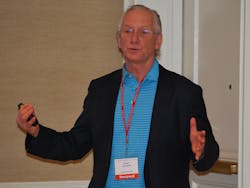Sustainability initiatives are getting leaner and more technology-focused.
Organizations can apply the same continuous-improvement strategies that have cut waste and improved quality for decades on plant floors to build a sustainability culture, said Evan Van Hook, Honeywell’s chief sustainability officer.
Van Hook discussed his company’s approach to sustainability during the 2023 Honeywell Users Group in Orlando, Florida.
Honeywell’s efforts have led to significant sustainability wins since 2010, including 6,300 projects yielding total annualized savings of $110 million. Honeywell also has reduced its carbon intensity by more than 90% since 2004, the year the company launched its sustainability program. While some companies may see sustainability initiatives as a burden, Van Hook noted that they have real business benefits. As an example, Honeywell has seen a 70% energy-efficiency improvement over the past two decades.
The company’s largest projects have involved more than 1,900 lighting upgrades, compressed-air and gas and leak management upgrades, the implementation of variable frequency drives, HVAC modifications and control-system upgrades and replacements.
Van Hook explained how Honeywell continues to set ambitious targets using continuous improvement as its foundation. The company applies its lean-manufacturing program to generate transformative results in sustainability.
“What we did is we built sustainability directly into our core lean-based central processes we call the Honeywell Operating System, which is based on a lot of activities like finding ways to improve things, whether it’s in quality, delivery, inventory or sustainability,” Van Hook said.
It begins with cross-functional collaboration, including lean brainstorming sessions called kaizen events, with the facilities teams to identify which project to fund, Van Hook said. The company has committed to spending $50 million a year on sustainability projects, he added. The process is backed by data, using advanced technologies, such as Rebellion hyperspectral imaging, to view and analyze fugitive emissions sources.
Technology plays a crucial role in sustainability initiatives because organizations can’t improve what they can’t measure. At Honeywell, technology provides visibility into the sources of emissions at its 900 facilities around the world.
“With Honeywell’s and others’ technologies, we can tell you exactly how much every one of our 900 facilities globally emits,” Van Hook said. “And we can tell you from where those emissions come. Is it natural gas? Is it process? Is it electricity? You have to start with that because that tells you where your real targets are.”
In fact, industry has seen a major shift from process-oriented approaches to addressing sustainability to technology-focused initiatives. Van Hook pointed to results from Honeywell’s Environmental Sustainability Index for the first quarter of 2023.
While process and behavior solutions still dominate, the survey of about 750 chief sustainability officers showed that organizations are increasingly balancing that approach with technology solutions. They’re also showing increased optimism that they will meet their sustainability targets over the next 12 months and in the long term.
Van Hook also discussed the company’s efforts around emissions-reporting transparency. Honeywell publicly reports its greenhouse gas emissions through the Carbon Disclosure Project (CDP) global reporting index. Since 2011, Honeywell has used a third party to verify its emissions-reporting figures. Establishing reporting credibility is critical considering the potential social impact of the company’s short- and long-term goals.
By 2024, Honeywell is aiming to cut scope 1 and 2 emissions intensity by another 10% from 2018 levels, deploy at least 10 renewable energy projects and achieve the ISO 50001 energy-management standard at 10 sites.
In the long term, Honeywell has committed to being carbon neutral in scope 1 and 2 emissions by 2035, 15 years ahead of the Paris Agreement to reach net zero by 2050. The company is looking to cut its U.S. scope 1 and 2 emissions in half by 2030.
In addition, Honeywell has been approved by the Science-Based Target Initiative (SBTi) to address its Scope 3 emissions. SBTi is a nongovernmental organization that sets targets consistent with the Paris Agreement. SBTi extends to scopes 1, 2 and 3. Honeywell is the largest manufacturing company that has an approved SBTi target, Van Hook said.
“We were pretty scared going into it because it’s a big challenge; they are very strict, but we went in there with very good data and got the approval very quickly,” he said.
One of the ways Honeywell expects to meet Scope 3 targets is by helping its customers cut emissions. He pointed to products, such as the company’s Solstice refrigerants technology, which is designed to help customers lower their carbon footprints and improve energy efficiency. That one product has kept about 300 million metric tons of carbon dioxide out of the atmosphere, he said. About 60% of Honeywell’s research-and-development investments are going toward environmental and social improvement products.
“Our customers wanted them; we devote our R&D to that; we make things that make our customers happy; and meanwhile, because they’re using products that emit less, our Scope 3 emissions go down,” Van Hook said.
About the Author

Leaders relevant to this article:
